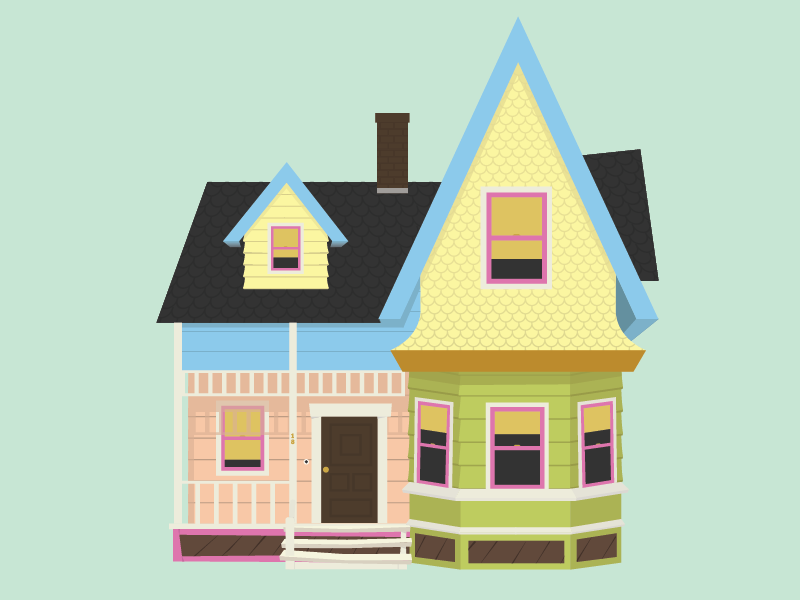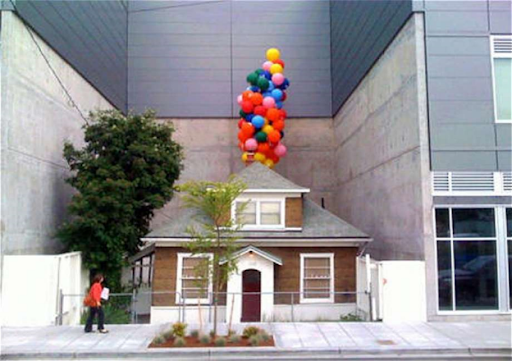
(Image: Pinterest)
Architecture Is Only Temporary
by Nick Tarver
Produced by Pixar Animation Studios, the movie Up highlights the life of Carl Fredricksen, an elderly, recently widowed man. Along the way, Fredricksen meets two unlikely companions that would accompany him during his journey to fulfill his promise that he made to his late wife, Ellie. Aside from the feel-good storyline, the film offers an architectural aspect that explores the human connection to the built environment. Fredricksen has a hard time coming to terms with the death of his wife and it seems like everything he is surrounded by reminds him of her. Fredricksen, with the help of his two new friends, Russell and Dug, decides the only way he would fulfill his and his wife’s dream of seeing the ins-and-outs of South America would be to take his house, which ultimately symbolizes Ellie, with him. Up demonstrates the idea of place and how the built environment has the ability to emotionally and spiritually resonate with an individual, ultimately resulting in equally positive and negative impacts on both a personal and societal level.

(Image: Walt Disney/Pixar)
Place, architecturally speaking, is an abstract concept that is made up of an individual’s experiences and multi-dimensional personal connections to a physical setting (1). Not one place is like another—each user-place relationship is unique to the individual and becomes an essential role in human life (2). With that being said, Place Attachment Theory is the idea that humans have the ability to form specific attachments to places, usually based on the emotions and feelings that sparked during his/her first encounter with said place (3). Attachments can form in any number of places, but typically, there are three dimensions of place: the home (dwelling), the neighborhood, and the district and/or city (4). Due to the countless memories and positive emotions associated with his home and his opposing despise for the development of his surrounding neighborhood, Carl Fredricksen’s attachment can be solely categorized under the first dimension of place, which may not be an uncommon dynamic. According to a 2001 study that assessed the different levels of place attachments and those who experienced them, researchers found that the majority of individuals surveyed had the strongest physical connection to his/her district/city, while emotionally, the home/dwelling proved to have the strongest attachment among participants. Researchers also concluded that attachments, both physical and emotional, increase in intensity as people age (5).

Edith Macefield’s home in the Ballard neighborhood of Seattle. (LINK)
Harvesting positive attachments to place enables an increase in a successful and comfortable user experience, which is an effective tool in terms of marketing and design, but can pose as an issue when considering the inevitable nature of change and growth (6). While the storyline of Up does lend to the beneficial aspect that place attachments have on our emotional and physiological well-being, Fredricksen’s case primarily highlights the harsh realities that come with forming tight-knit relationships with the built environment. His attachment caused him to reject change and forced him into taking extreme measures in the attempt to prolong his current chapter of life for as long as he can. Despite this, there is some validity in the idea that humans find a sense of comfort in the preservation of individual and community legacy. The story of Edith Macefield, a longtime resident of the Ballard neighborhood in Seattle, proves that change itself and the need to protect history is in fact the sole motivators behind the desire to stay the same for some people. Before her death in 2008 from pancreatic cancer, Macefield refused to hand over her home to developers, even after being offered close to one million dollars to do so. After failed attempts to change Macefield’s mind, the company resorted to continuing construction efforts around the perimeter of the hundred-year-old-house, completely respecting the integrity of the structure’s legacy (7).
Macefield’s story can almost perfectly parallel that of Fredricksen’s—both characters struggled with adapting to the change happening in their surrounding neighborhoods and experienced seemingly unbreakable attachments to their homes. Where the two differ, however, is at the conclusions of their stories. While Macefield spent her entire life fighting to preserve her heritage and that of the original community of Ballard, Fredricksen came around to the idea of finding a balance between honoring the past while investing in the development of the future and new generations to come. Peter Eisenman, a deconstructivism architect and theorist most famously recognized for his few, yet ideologically underpinned works during the modernist and postmodernist eras, believes that the attachments that humans form with their physical surroundings actually present themselves as barriers in terms of forward-thinking architecture and planning. “People have been concerned with relating themselves to their physical environments as a source of security. I believe that if the physical environment makes them anxious, they might turn inward, and the true source of security is internal. The physical environment can never provide that, it can provide physical comfort, shelter, but it can never provide psychological shelter,” Eisenman is quoted (8). While his somewhat-brutal ideology seems to completely reject human emotions as they relate to architecture, Eisenman’s theory does provide vital information towards achieving a successfully-built future. Aspects of Eisenman’s philosophy, specifically regarding his point that psychological security should be sought from within the individual rather than the physical environment, used in tandem with notion that the built environment and design are continuously evolving, contribute to the logistics of the architectural future.

Carl Fredricksen's home suspended by balloons and surrounded by a developing urban environment. (LINK)
Pixar Studio’s film, Up, provides is an interesting interpretation of a classic antagonist-turned-protagonist storyline, embedded with current architectural issues and concepts. Carl Fredricksen fears the unknown of a future without his home, the structure he formed a lifelong emotional and physical attachment to. Although place attachments, in many cases, act as beneficial proponents to human life and an individual’s psychological well-being, other times, attachments are the cause behind a person’s inability to accept the certainty that is change. While Peter Eisenman provides a rational approach to remedying the sometimes-extreme nature of place attachments, his ideology misses the mark when considering how essential human emotions are in connection to architecture. So, how can there be a balance between the two? Place attachments can occur on both an individual and societal level, so can the solutions to finding a logical-meets-psychological equilibrium amongst the user and the place. Designers can still create an emotional experience within the built environment, supporting positive and healthy place attachments at an individual level, whereas on a larger scale, communities can promote changes in development by continuously honoring and remembering the past through utilizing historical knowledge and traditions to aid in the betterment of architecture for years to come.
CITATIONS
1. Mina Najafi and Mustafa Kamal Bin Mohd Shariff, “The Concept of Place and Sense of Place in Architectural Studies,” International Science Index, Humanities and Social Sciences Vol:5, No:8, 2011.
2. Ibid.
3. Ibid.
4. Sarah Elizabeth Jelley, “A study of place attachment,” School of Management and Marketing, University of Wollongong, pg. 2, 2013, accessed Nov. 26, 2019, https://ift.tt/2sOMWpb.
5. Ibid., pg. 13.
6. Ibid., pg. 11.
7. Casey McNerthney, “Seattle's 'Up' house and Edith Macefield: Read a Q&A about the Ballard landmark,” Kiro 7 News, 2018, accessed Nov. 30, 2019, https://ift.tt/350ga2z.
8. Husam AlMuzainy, “Deconstruction Architecture,” SlideShare, pg. 31, 2013, accessed Dec. 1, 2019, https://ift.tt/2YpGoJk.
BIBLIOGRAPHY
AlMuzainy, Husam. “Deconstruction Architecture.” SlideShare. Pg. 31. 2013. Accessed Dec. 1, 2019. https://ift.tt/2YpGoJk.
Jelley, Sarah Elizabeth. “A study of place attachment.” School of Management and Marketing, University of Wollongong. Pg. 2-13. 2013. Accessed Nov. 26, 2019, https://ift.tt/2sOMWpb.
McNerthney, Casey. “Seattle's 'Up' house and Edith Macefield: Read a Q&A about the Ballard landmark,” Kiro 7 News. 2018. Accessed Nov. 30, 2019, https://ift.tt/350ga2z.
Najafi, Mina and Shariff, Mustafa Kamal Bin Mohd. “The Concept of Place and Sense of Place in Architectural Studies,” International Science Index, Humanities and Social Sciences Vol:5, No:8. 2011.

LOGO DESIGNED BY MEENTS ILLUSTRATED
from REVIEW BLOG - Every Movie Has a Lesson https://ift.tt/2s7iTbS







No comments:
Post a Comment